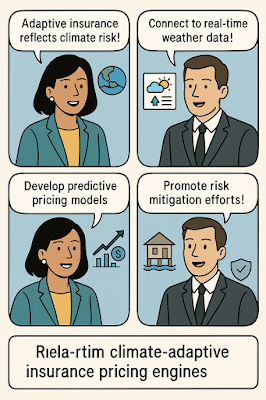How to Develop Real-Time Climate-Adaptive Insurance Pricing Engines
How to Develop Real-Time Climate-Adaptive Insurance Pricing Engines
As climate change accelerates, traditional insurance pricing models struggle to keep pace with growing risks.
Real-time climate-adaptive pricing engines offer a breakthrough by using weather data, AI, and advanced analytics to adjust premiums dynamically based on evolving risk factors.
This post explores how to develop these engines and their potential to transform insurance underwriting.
Table of Contents
- Why Climate-Adaptive Pricing Matters
- Key Components of Adaptive Pricing Engines
- Steps to Develop and Deploy These Engines
- Challenges and How to Overcome Them
- The Future of Climate-Adaptive Insurance
Why Climate-Adaptive Pricing Matters
Extreme weather events, rising sea levels, and shifting risk zones are reshaping insurance markets.
Adaptive pricing enables insurers to reflect current conditions, improving risk accuracy and reducing losses.
It also incentivizes customers to take proactive measures, such as flood-proofing or wildfire mitigation, to lower premiums.
Key Components of Adaptive Pricing Engines
Integration with real-time weather and climate data feeds.
AI models that analyze historical, real-time, and forecast data to predict risk exposure.
Dynamic pricing algorithms that adjust premiums as conditions change.
User interfaces that provide transparency and explain price changes to customers.
Steps to Develop and Deploy These Engines
Define the risk models for various perils such as floods, wildfires, and hurricanes.
Partner with climate data providers and integrate IoT sensors where appropriate.
Build, train, and validate machine learning models using diverse datasets.
Pilot the engine in select markets, monitor performance, and optimize algorithms before scaling.
Challenges and How to Overcome Them
Accessing high-quality, granular climate data can be difficult; establish strong data partnerships.
Customer acceptance may be low without clear communication; use transparency tools to explain pricing logic.
Regulatory compliance must be ensured across jurisdictions; engage legal and compliance teams early.
The Future of Climate-Adaptive Insurance
Expect broader use of parametric insurance, where payouts are triggered by climate thresholds.
AI will enable hyper-local risk assessment, improving pricing precision.
As climate risk becomes mainstream, adaptive pricing will be essential to protect both insurers and policyholders.
Recommended Resources
Explore these related insights:
Apply AI in financial markets.
Streamline risk assessment in insurance deals.
Prevent fraud in financial and insurance services.
Learn about compliance in health tech.
Improve climate transparency in finance.
Keywords: climate risk, adaptive insurance, AI pricing, underwriting, weather data
